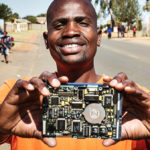This post originally appeared on Huffington Post ImpactX.
Last week I wrote about collaboration for the Skoll World Forum for Social Entrepreneurship — specifically about how, despite the prevalence of technology, human interactions and relationships are at the heart of successful collaboration.
In that post, I said technology enables collaboration and innovation to happen on a global scale. And, that a technology infrastructure that supports collaboration can accelerate time to impact for any nonprofit, social entrepreneur, or business.
While at Skoll, I participated in a session that brought both of these elements — people and technology — together and underscored the potential we have to make a bigger and more meaningful impact when they are combined.
The session, “Blended Learning: The Proof and the Promise,” gave us a glimpse of what the classroom of the future might look like: students working at a self-paced rate and getting feedback as they progress, education being personalized, the use of gaming and simulation technologies. Imagine kids who are interested and engaged, excited to be in school, their creativity being nurtured, not squelched.
In the session, the panel debated whether the use of technology can radically improve educational quality and access globally. I believe it can, because Cisco has used this blended learning model successfully for years to deliver its Networking Academy curriculum to 4.25 million people in 165 countries.
Networking Academy teaches people to design, build, maintain, and secure computer networks. The curriculum is delivered through a combination of classroom instruction, hands-on activities, online curricula, labs, network simulations, and online assessments. Because the blended learning model uses visual, auditory, and tactile participation, there are more opportunities for students to have “authentic practice” as well as imparting greater, deeper understanding of the curriculum.

For example, we use an educational game called Cisco Aspire that provides realistic business and computer networking scenarios. Students use this to make business and technical decisions to complete projects for clients.
Research suggests that authentic context such as this engages students and can increase their motivation to perform well. As students become more motivated, their scores become a more accurate reflection of their skills and abilities.
Networking Academy uses sophisticated online assessment tools that give immediate feedback. The beauty of this approach is that students can learn from their mistakes and build a strong foundation in the subject matter. The feedback also shows instructors how students are solving problems and arriving at answers, so they can refine their teaching accordingly.
Of course, real, in-the-flesh instructors are still a vital part of the blended learning model. For example, in Saudi Arabia, Cisco Networking Academy instructor Dr. Akila Sarirete mentors and challenges her all-female student body to embrace technology as a vehicle for both personal and career growth. In Bulgaria, Networking Academy instructor Stela Stefanova has transformed a deteriorating Soviet-era high school into a technical education powerhouse. She is beloved by her students.

The Cisco Networking Academy is just one of many programs using a blended leaning model today. While at Skoll it was wonderful to talk with and listen to leading innovators exploring what is working in classrooms and at home, we all need to continue the conversation on how successful solutions can be spread and what challenges must still be overcome.
Finally, after years of hype, there is exciting progress in applying technology to deliver scalable, high quality education, even to those in some of the world’s most challenging environments. With the many problems facing educational systems today, blended learning has the power to transform both classrooms and people’s lives.


CONNECT WITH US